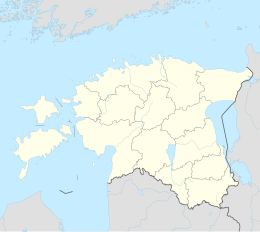Kuigatsi
| Kuigatsi | ||
| State : |
|
|
| Circle : |
|
|
| Coordinates : | 58 ° 1 ′ N , 26 ° 12 ′ E | |
| Residents : | 76 (January 1, 2006) | |
| Time zone : | EET (UTC + 2) | |
|
|
||
Kuigatsi (German Kuikatz , from 1803 Löwenhof ) is a village ( Estonian küla ) in the Estonian rural community Otepää (until 2017 Puka ) in Valga County . It is located about 30 km northeast of the Estonian-Latvian border town of Valga ( Walk ). Kuigatsi has 76 inhabitants (as of January 1, 2006).
Place and history
A pagan fortress ( linnamägi ) from the 1st millennium AD has been found near Kuigatsi .
Kuigatsi was first mentioned in 1366 when a certain Henneke von Walmus sold his father's farm. The Dort Kuigatsi has been recorded since 1466. From 1869 to 1950 the place was the center of the rural community of the same name ( Kuigatsi vald ).
Good Kuigatsi
The Kuigatsi manor has been documented since 1509 ( Koywkatz ). In its history it was owned by the Dumpian, Dücker , von Löwenstern (1776–1883) and von Nolcken (1883–1919) families .
During the Polish rule of Livonia , it was owned by the Jesuits . In 1776 Paul Ludwig Johann von Löwenstern bought the property. The historic German-speaking name Löwenhof , which was made official in 1803, comes from the Löwenstern family .
The late baroque mansion of Kuigatsi was built in the 1770 / 80s on a stone base made of wood. Two two-story wings were built on the park side. The facades are in the style of late classicism . The manor house was extensively remodeled in the second half of the 19th century and in the 20th century and a large greenhouse was added.
In the course of the Estonian land reform , the last owner, Josephine von Nolcken (née von Löwenstern), was expropriated by the Estonian state.
The historic manor house and some outbuildings such as the administrator's house as well as the stables and the coach house are still preserved. The mansion is now privately owned again, after initially housing a school and from 1975 to 2001 a boarding school for disabled children. On the road between Võru and Tõrva there is also a historic tavern from the 18th century and the baroque servant's house.
Kuigatsi is the birthplace of the Baltic German painter Friedrich Sigismund Stern (1812–1889).
literature
- Ivar Sakk: Eesti mõisad. Rice yuht. Tallinn 2002 ( ISBN 9985-78-574-6 ), p. 259
Web links
- History, pictures and news about Kuigatsi (Estonian and English)
- Description of the place (Estonian)
- Gut Kuigatsi (German)


